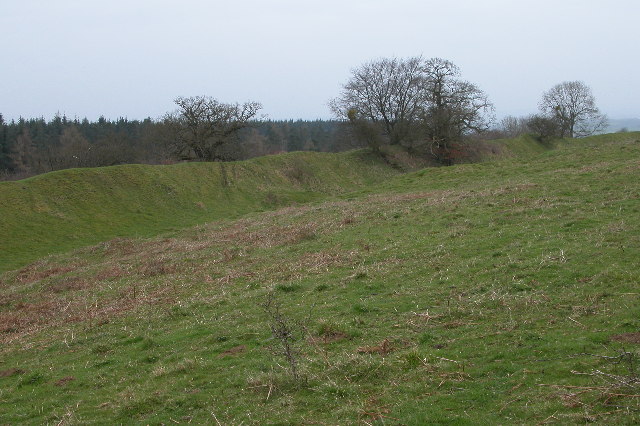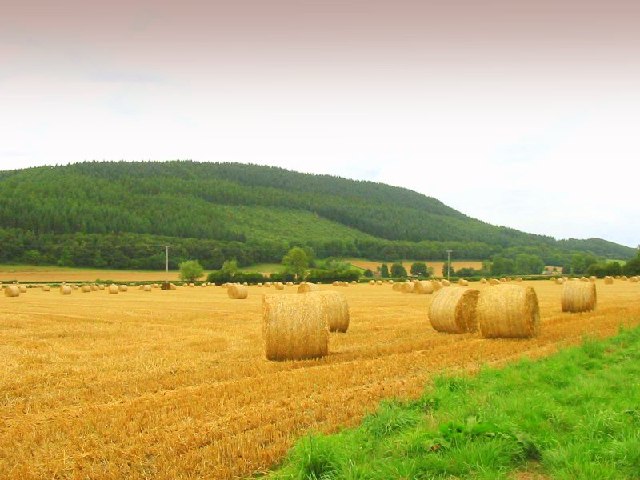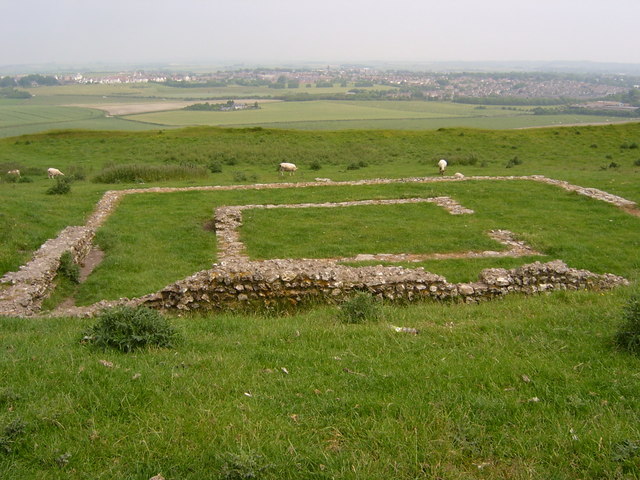|
Croft Ambrey
Croft Ambrey is an Iron Age hill fort in Herefordshire, England. Location Croft Ambrey, on Yatton Hill, is in the civil parish of Aymestrey, north from Leominster, south-east from the South Shropshire border, and approximately east from the Wales border. The fort is on high ground beyond and adjoining the north-east boundary of National Trust Croft Castle parkland. The nearest settlements are the villages of Yarpole, Aymestrey and Yatton, and the hamlet of Mortimer's Cross. The Mortimer Trail waymarked long-distance footpath passes the site. Description The monument includes a small multivallate hillfort with an annexe containing a Romano-Celtic temple and a medieval warren of up to five pillow mounds on the summit of a prominent steeply sloping spur overlooking Yatton Marsh and the valley of a tributary to Allcock's Brook. The hillfort survives as a roughly triangular enclosure defined to the north by two scarps with a buried ditch: to the west by three rampart bank ... [...More Info...] [...Related Items...] OR: [Wikipedia] [Google] [Baidu] |
Aymestrey
Aymestrey ( ) is a village and civil parish in north-western Herefordshire, England. The population of this civil parish, including the hamlet of Yatton, at the 2011 Census was 351. Location It is located on the A4110 road, about 7 miles north-west of Leominster and 8 miles south-west of the historic market town of Ludlow, in south Shropshire. The village is on the River Lugg. Amenities and history Aymestrey is home to several homes and cottages, the church dedicated to St John the Baptist and St Alkmund, a village hall and a pub or Inn: The Riverside Inn, situated next to River Lugg just off the main road. The Mortimer Trail ''geograph.org.uk'' waymarked recreational walk passes through the village. [...More Info...] [...Related Items...] OR: [Wikipedia] [Google] [Baidu] |
Mortimer Trail
The Mortimer Trail is a waymarked long-distance footpath and recreational walk in the counties of Shropshire and Herefordshire in England. The route The route is named after the Mortimer family of ruling Marcher Lords, often titled Earl of March, whose rise through successive generations from Norman times through the medieval period helped to shape the history and geography of this area of the Welsh Marches. The route runs between Ludlow Castle, the former headquarters of the Council of the Marches and a seat of Mortimer power, and Kington, Herefordshire, in the quiet west of the county near the Welsh border. The route crosses the River Teme and enters Mortimer Forest, an area of forested ridges. It passes Croft Castle and the Iron Age hill fort Croft Ambrey (not far from Wigmore and the initial seat of Mortimer power), and then passes through quiet Aymestrey. Near Aymestrey it passes through Puckhouse Wood, reputedly haunted by pucks or wood sprites. According to lore, ... [...More Info...] [...Related Items...] OR: [Wikipedia] [Google] [Baidu] |
Wapley Hill
Wapley Hill is an Iron Age hill fort in Herefordshire, England, 3 km south-east of Presteigne. Location Wapley Hill stands in mixed woodland on a west-facing escarpment to the south of the B4362 road from Presteigne to Mortimer's Cross. The Herefordshire Trail way-marked long distance footpath passes through the site. Description The defences stand at a height of 5.6 m and occupy 6 hectares. The entrance is situated on the southern side and comprises a 90 m passage. A 'ritual shaft' dating from the late Bronze Age The Bronze Age is a historic period, lasting approximately from 3300 BC to 1200 BC, characterized by the use of bronze, the presence of writing in some areas, and other early features of urban civilization. The Bronze Age is the second prin ... is sunk to a depth of 33 m. Further reading *Children, G; Nash, G (1994) ''Prehistoric Sites of Herefordshire'' Logaston Press External linksWapley Hill at PastScape [...More Info...] [...Related Items...] OR: [Wikipedia] [Google] [Baidu] |
Iron Age
The Iron Age is the final epoch of the three-age division of the prehistory and protohistory of humanity. It was preceded by the Stone Age (Paleolithic, Mesolithic, Neolithic) and the Bronze Age (Chalcolithic). The concept has been mostly applied to Iron Age Europe and the Ancient Near East, but also, by analogy, to other parts of the Old World. The duration of the Iron Age varies depending on the region under consideration. It is defined by archaeological convention. The "Iron Age" begins locally when the production of iron or steel has advanced to the point where iron tools and weapons replace their bronze equivalents in common use. In the Ancient Near East, this transition took place in the wake of the Bronze Age collapse, in the 12th century BC. The technology soon spread throughout the Mediterranean Basin region and to South Asia (Iron Age in India) between the 12th and 11th century BC. Its further spread to Central Asia, Eastern Europe, and Central Europe is somewhat dela ... [...More Info...] [...Related Items...] OR: [Wikipedia] [Google] [Baidu] |
Rotary Quern
Quern-stones are stone tools for hand-grinding a wide variety of materials. They are used in pairs. The lower stationary stone of early examples is called a saddle quern, while the upper mobile stone is called a muller, rubber or handstone. The upper stone was moved in a back-and-forth motion across the saddle quern. Later querns are known as rotary querns. The central hole of a rotary quern is called the eye, and a dish in the upper surface is known as the hopper. A handle slot contained a handle which enabled the rotary quern to be rotated. They were first used in the Neolithic era to grind cereals into flour. Uses of quern-stones An old Gaelic proverb is "The quern performs best when the grindstone has been pitted." Design of quern-stones The upper stones were usually concave while the lower ones were convex. Quern-stones are frequently identifiable by their grooved working surfaces which enabled the movement of flour. Sometimes a millrind was present as a piece of wood (or o ... [...More Info...] [...Related Items...] OR: [Wikipedia] [Google] [Baidu] |
Saddle Querns
The saddle is a supportive structure for a rider of an animal, fastened to an animal's back by a girth. The most common type is equestrian. However, specialized saddles have been created for oxen, camels and other animals. It is not known precisely when riders first began to use some sort of padding or protection, but a blanket attached by some form of surcingle or girth was probably the first "saddle", followed later by more elaborate padded designs. The solid saddle tree was a later invention, and though early stirrup designs predated the invention of the solid tree, the paired stirrup, which attached to the tree, was the last element of the saddle to reach the basic form that is still used today. Today, modern saddles come in a wide variety of styles, each designed for a specific equestrianism discipline, and require careful fit to both the rider and the horse. Proper saddle care can extend the useful life of a saddle, often for decades. The saddle was a crucial step in ... [...More Info...] [...Related Items...] OR: [Wikipedia] [Google] [Baidu] |
Pillow Mounds
A warren is a network of wild rodent or lagomorph, typically rabbit burrows. Domestic warrens are artificial, enclosed establishment of animal husbandry dedicated to the raising of European Rabbit, rabbits for meat and fur. The term evolved from the medieval Anglo-Normans, Anglo-Norman concept of free warren, which had been, essentially, the equivalent of a hunting license for a given woodland. Architecture of the domestic warren The Cunicularium, cunicularia of the monasteries may have more closely resembled Hutch (animal cage), hutches or pens, than the open enclosures with specialized structures which the domestic warren eventually became. Such an enclosure or ''close'' was called a ''cony-garth'', or sometimes ''conegar'', ''coneygree'' or "bury" (from "burrow"). Moat and pale To keep the rabbits from escaping, domestic warrens were usually provided with a fairly substantive moat, or ditch filled with water. Rabbits generally do not swim and avoid water. A ''wikt:pale, pale'' ... [...More Info...] [...Related Items...] OR: [Wikipedia] [Google] [Baidu] |
Burrow
An Eastern chipmunk at the entrance of its burrow A burrow is a hole or tunnel excavated into the ground by an animal to construct a space suitable for habitation or temporary refuge, or as a byproduct of locomotion. Burrows provide a form of shelter against predation and exposure to the elements, and can be found in nearly every biome and among various biological interactions. Many animal species are known to form burrows. These species range from small invertebrates, such as the ''Corophium arenarium'', to very large vertebrate species such as the polar bear. Burrows can be constructed into a wide variety of substrates and can range in complexity from a simple tube a few centimeters long to a complex network of interconnecting tunnels and chambers hundreds or thousands of meters in total length; an example of the latter level of complexity, a well-developed burrow, would be a rabbit warren. Vertebrate burrows A large variety of vertebrates construct or use burrows in many t ... [...More Info...] [...Related Items...] OR: [Wikipedia] [Google] [Baidu] |
Romano-Celtic Temple
A Romano-Celtic temple (more specifically a Romano-British temple in Great Britain, or Gallo-Roman temple in the Continental region formerly comprising Gaul) is a sub-class of Roman temple found in the north-western provinces of the Roman Empire. Many may have had roots in the late Iron AgeLewis, M.J.T. 1966. ''Temples in Roman Britain'' (Cambridge Classical Studies). Cambridge: Cambridge University Press. pp49-50 either in direct relation to pre-Roman structures or on sites with pre-Roman activity. Layout Each temple normally consisted of a box-like '' cella'', of variable height, surrounded by an ambulatory or verandaLiversidge, J. 1973. ''Britain in the Roman Empire''. New York: F.A. Praeger pp439 built from stone, wood or both. This floor-plan is typically square or rectangular, but triangular, circular and polygonal layouts are also known. In size they vary considerably with the outer ambulatory ranging from 8.5m to 22m in length and the ''cella'' from 5.1m to 16m A c ... [...More Info...] [...Related Items...] OR: [Wikipedia] [Google] [Baidu] |
Hillfort
A hillfort is a type of earthwork used as a fortified refuge or defended settlement, located to exploit a rise in elevation for defensive advantage. They are typically European and of the Bronze Age or Iron Age. Some were used in the post-Roman period. The fortification usually follows the contours of a hill and consists of one or more lines of earthworks, with stockades or defensive walls, and external ditches. Hillforts developed in the Late Bronze and Early Iron Age, roughly the start of the first millennium BC, and were used in many Celtic areas of central and western Europe until the Roman conquest. Nomenclature The spellings "hill fort", "hill-fort" and "hillfort" are all used in the archaeological literature. The ''Monument Type Thesaurus'' published by the Forum on Information Standards in Heritage lists ''hillfort'' as the preferred term. They all refer to an elevated site with one or more ramparts made of earth, stone and/or wood, with an external ditch. Many ... [...More Info...] [...Related Items...] OR: [Wikipedia] [Google] [Baidu] |
Multivallate
A hillfort is a type of earthwork used as a fortified refuge or defended settlement, located to exploit a rise in elevation for defensive advantage. They are typically European and of the Bronze Age or Iron Age. Some were used in the post-Roman period. The fortification usually follows the contours of a hill and consists of one or more lines of earthworks, with stockades or defensive walls, and external ditches. Hillforts developed in the Late Bronze and Early Iron Age, roughly the start of the first millennium BC, and were used in many Celtic areas of central and western Europe until the Roman conquest. Nomenclature The spellings "hill fort", "hill-fort" and "hillfort" are all used in the archaeological literature. The ''Monument Type Thesaurus'' published by the Forum on Information Standards in Heritage lists ''hillfort'' as the preferred term. They all refer to an elevated site with one or more ramparts made of earth, stone and/or wood, with an external ditch. Many ... [...More Info...] [...Related Items...] OR: [Wikipedia] [Google] [Baidu] |
Croft Ambrey - Geograph
Croft may refer to: Occupations * Croft (land), a small area of land, often with a crofter's dwelling * Crofting, small-scale food production * Bleachfield, an open space used for the bleaching of fabric, also called a croft Locations In the United Kingdom *Croft, Cheshire, in the Borough of Warrington *Croft, Leicestershire *Croft, Lincolnshire *Croft, Herefordshire **Croft Castle, Herefordshire *Croft-on-Tees, North Yorkshire * Croft (Aberdeenshire castle), a former keep in Scotland * The Croft, a listed house in Totteridge, Barnet *Croft Circuit, a motor racing circuit in northeast England In the United States * Croft, California, in El Dorado County * Croft, Kansas People * Croft (surname) * Crofts (surname) See also *Crofts End, Bristol *Crofton, Cumbria *Crofton, British Columbia *Ashcroft (other) *Undercroft An undercroft is traditionally a cellar or storage room, often brick-lined and vaulted, and used for storage in buildings since medieval times. In mo ... [...More Info...] [...Related Items...] OR: [Wikipedia] [Google] [Baidu] |



_1934.jpg)




